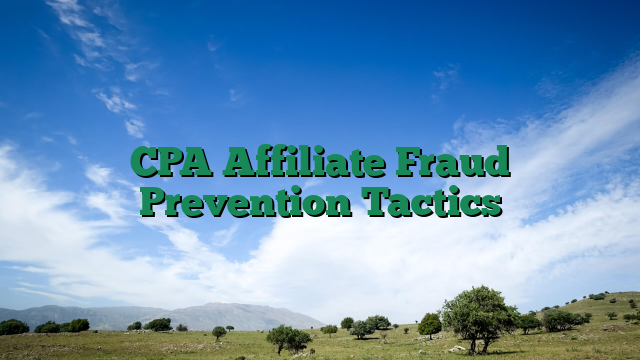CPA Affiliate Fraud Prevention Tactics: How to Protect Your Earnings
CPA (Cost Per Action) affiliate marketing is a lucrative way to earn passive income, but fraud can quickly drain your profits. Whether you’re a beginner or an experienced affiliate, understanding CPA fraud prevention is crucial to maintaining a sustainable business.
In this guide, we’ll cover:
✔ Common types of affiliate fraud
✔ How fraudsters manipulate CPA networks
✔ Actionable fraud prevention tactics
✔ Tools for traffic verification
✔ How to monetize fraud-proof CPA campaigns
By the end, you’ll have a clear strategy to protect your earnings and scale your CPA side hustle safely.
1. Understanding CPA Affiliate Fraud
Fraud in CPA marketing happens when affiliates or third parties fake conversions to earn illegitimate commissions. This can lead to:
– Network bans (losing your account)
– Chargebacks (reversed payments)
– Wasted ad spend (paying for fake leads)
Common Types of CPA Fraud
A. Fake Leads & Bot Traffic
Fraudsters use bots or automated scripts to submit fake form fills, clicks, or sign-ups. Since CPA pays per action, these fake conversions cost advertisers money.
Example: A user runs a bot that fills out 1,000 fake insurance leads—earning commissions without real users.
B. Cookie Stuffing
Affiliates force their tracking cookies onto users who didn’t click their links. If the user later converts, the fraudster gets credit.
Example: A malicious affiliate injects their tracking ID into a user’s browser via malware or hidden iframes.
C. Incentivized Fraud
Some affiliates pay users to complete offers, violating CPA network policies. These leads often result in high refund rates.
Example: A user is paid $1 to sign up for a free trial, but they cancel immediately—costing the advertiser.
D. Ad Stacking & Pixel Stuffing
Fraudsters stack multiple ads in one hidden pixel or overlay fake clicks to inflate impressions.
Example: A site loads 10 CPA ads in a 1×1 pixel, tricking trackers into counting fake clicks.
2. How Fraudsters Target CPA Networks
Fraudsters exploit weaknesses in:
– Tracking systems (fake referrals, cookie hijacking)
– Conversion verification (fake form submissions)
– Ad networks (bot traffic, click spoofing)
Result? Legitimate affiliates lose trust, and networks tighten restrictions—making it harder for honest marketers to scale.
3. CPA Fraud Prevention Tactics (Actionable Steps)
✅ 1. Use Fraud Detection Tools
Invest in tools that analyze traffic quality and flag suspicious activity:
– FraudScore (Detects bots & fake leads)
– Voluum (Tracks conversions & traffic sources)
– ClickCease (Prevents click fraud in PPC campaigns)
Pro Tip: Most CPA networks have built-in fraud filters—ask your affiliate manager about them.
✅ 2. Monitor Conversion Patterns
Look for red flags like:
– Too many conversions from one IP
– Unusually high CTRs (click-through rates)
– Low time-on-page before conversions
Action Step: Use Google Analytics + heatmaps (Hotjar) to verify user behavior.
✅ 3. Avoid Shady Traffic Sources
Not all traffic is equal. Avoid:
– Low-quality pop/push networks (high bot rates)
– Click farms (paid users completing offers)
– Tor/Proxy traffic (often used for fraud)
Better Alternatives:
– Native ads (Taboola, Outbrain)
– Facebook/Google Ads (higher-quality users)
– SEO & organic traffic (long-term sustainability)
✅ 4. Implement CAPTCHA & Phone Verification
Adding CAPTCHA or SMS verification stops bots from submitting fake leads.
Example: A loan offer requiring phone verification filters out fake submissions.
✅ 5. Work with Reputable CPA Networks
Some networks have stronger fraud prevention than others. Stick with trusted ones like:
– MaxBounty (strict approval process)
– OGAds (specializes in mobile CPA)
– ClickDealer (real-time fraud monitoring)
Warning: Avoid networks with delayed payments or high complaint rates (check forums like STM/BlackHatWorld).
✅ 6. Regularly Audit Your Campaigns
- Check for sudden spikes in conversions
- Compare conversions vs. actual sales (if possible)
- Test your own offers (submit fake leads to see if they get caught)
Pro Tip: Some networks allow postback URLs—use them to track real-time conversions.
4. Monetizing Fraud-Proof CPA Campaigns
Once you’ve secured your campaigns, focus on scaling profitably:
💰 1. Optimize for High-Converting Offers
- Use A/B testing (different landing pages, creatives)
- Target tier-1 countries (US, UK, CA—higher payouts)
- Leverage retargeting ads (convert warm leads)
💰 2. Build a White-Hat Email List
- Collect emails via lead magnets (free eBooks, tools)
- Send CPA offers via email marketing (higher trust = fewer fraud flags)
💰 3. Diversify Traffic Sources
- YouTube + SEO (long-term organic traffic)
- Quora/Reddit marketing (answer-related questions + CPA links)
- Influencer shoutouts (micro-influencers in your niche)
💰 4. Upsell with CPA Continuity Offers
Some CPA offers pay recurring commissions (e.g., SaaS trials, subscription boxes). These are harder to fake and provide passive income.
5. Final Thoughts: Protect & Scale
Fraud is an ongoing battle in CPA marketing, but with the right fraud prevention tactics, you can:
✔ Keep your account in good standing
✔ Maximize ROI on ad spend
✔ Build a sustainable side hustle
Next Steps:
1. Audit your current campaigns for fraud risks.
2. Implement at least 2-3 prevention tactics from this guide.
3. Scale with high-quality traffic to boost earnings.
Have you encountered CPA fraud before? Share your experiences in the comments! 🚀
Want More CPA Strategies?
📩 Subscribe for exclusive affiliate tips → [Your Newsletter Link]
💬 Join our free Facebook group → [Your Community Link]
By following these steps, you’ll reduce fraud risk and increase CPA profits—making your affiliate marketing journey smoother and more profitable.
Now go secure those earnings! 💰🔒
🚀 Want to level up your online business? Join TheBizWizAcademy and start Networking and Learning!
